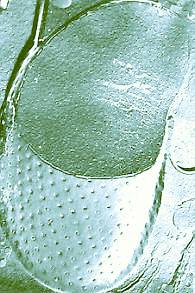
K. R. PORTER, A. CLAUDE and E. F. FULLAM (Rockefeller Institute, New York) published the first electron microscopic image of an animal cell in the Journal of Experimental Medicine in 1945. It showed a cultured fibroblast. The outlines of the cell were clearly visible, it looked frayed at the poles and the nucleus and a lot of fibrillar material within the cell's plasma were recognizable. The picture cannot keep up with today's standards. The pioneering work on the ultrastructure of animal and plant cells was done in the late forties and the fifties also at the Rockefeller Institute. Beside the scientists above, G. PALADE and M. C. LEDBETTER have been especially concerned with this matter.
Before the electron microscope could be used as a help in cell biology, two prerequisites had to be fulfilled and some of the basic work was done in the two studies just cited.
What can finally be seen in the microscope is chiefly dependent on the preparation techniques. It is already known from light microscopy that certain dyes are specific for certain structures and that several methods have to be used to get a picture of a cell.
Since electron microscopic preparations are very thin compared to the thickness of the whole cell, only one plane of the cell can be seen at a time so that it becomes necessary to check a number of slices to gain a realistic impression of the three-dimensional organization of intracellular structures. It was therefore not before extensive series of images had been prepared that models of the actual three-dimensional structures of the intracellular contents could be developed.
Many structures, that can be seen through an electron microscope are images of macromolecules or macromolecular complexes. All of them can nowadays be analyzed with methods of biochemistry or molecular biology and we know by now much more about their molecular structure and function. Only the structures themselves shall be shortly outlined in this review. Their function will be talked about elsewhere .
These days, the electron microscope is often used as an aid for the examination of the homogeneity of certain cell fractions like, for example, mitochondria, isolated DNA or genes, etc. It is impossible to analyze living cells with the electron microscope, because the preparations have to be contrasted and afterwards to be examined in a vacuum.
|
|